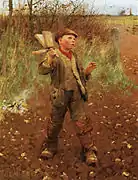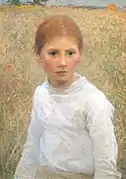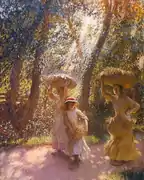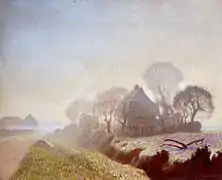George Clausen
Sir George Clausen RA (18 April 1852 – 22 November 1944) was a British artist working in oil and watercolour, etching, mezzotint, dry point and occasionally lithographs. He was knighted in 1927.[1]
George Clausen | |
|---|---|
 George Clausen – Self-portrait | |
| Born | 18 April 1852 London |
| Died | 22 November 1944 (aged 92) Cold Ash, Newbury, Berkshire |
| Nationality | British |
| Alma mater | |
| Known for | painting |
Biography
George Clausen was born in London on 18 April 1852, the son of a decorative artist of Danish descent. From 1867 to 1873, he attended the design classes at the South Kensington Schools in London with great success. He then worked in the studio of Edwin Long RA, and subsequently in Paris under Bouguereau and Tony Robert-Fleury at the Académie Julian.[2][3] He was an admirer of the naturalism of the painter Jules Bastien-Lepage about whom he wrote in 1888 and 1892.
Clausen became one of the foremost modern painters of landscape and of peasant life, influenced to a certain extent by the Impressionists, with whom he shared the view that light is the real subject of landscape art.[4] His pictures excel in rendering the appearance of things under flecking outdoor sunlight, or in the shady shelter of a barn or stable. His Girl at the Gate was acquired by the Chantrey Trustees and is now at the Tate Gallery.[3][5]
Clausen was a founding member of the New English Art Club in 1886. In 1895, he was elected an Associate of the Royal Academy, and a full Academician in 1906.[6] As Professor of Painting at the Royal Academy he gave a memorable series of lectures to the students of the Schools, published as Six Lectures on Painting (1904) and Aims and Ideals in Art (1906).[3][2]
Clausen was an official war artist during World War I. During the war his daughter's fiancé was killed; this event may have inspired his painting, Youth Mourning which shows a distressed young woman mourning in a desolate landscape.[7][8] Clausen also contributed six lithographs on the theme Making Guns for the Government published print portfolio Britain's Efforts and Ideals.[9]
In 1921 Clausen was an original member of the Society of Graphic Art and showed his work in their first exhibition.
- Selected works
 Bird scaring, 1887
Bird scaring, 1887 Girl, 1888
Girl, 1888 Ploughing, 1889
Ploughing, 1889 Brown eyes, 1891
Brown eyes, 1891 The Gleaners Returning, 1908
The Gleaners Returning, 1908_(RA)_-_Youth_Mourning.jpg.webp) Youth Mourning, 1916
Youth Mourning, 1916 Morning in November, 1922
Morning in November, 1922
References
- "Artist biography, George Clausen R.A". Tate. Retrieved 4 October 2016.
- Ian Chilvers (2004). The Oxford Dictionary of Art. Oxford University Press. ISBN 0-19-860476-9.
- Chisholm 1911.
- Brian Stewart & Mervyn Cutten (1997). The Dictionary of Portrait Painters in Britain up to 1920. Antique Collectors' Club. ISBN 1-85149-173-2.
- "Catelogue entry, The Girl at the Gate". Tate. Retrieved 4 October 2016.
- Frances Spalding (1990). 20th Century Painters and Sculptors. Antique Collectors' Club. ISBN 1-85149-106-6.
- Art from the First World War. Imperial War Museum. 2008. ISBN 978-1-904897-98-9.
- Imperial War Museum. "First World War archive, George Clausen". Imperial War Museum. Retrieved 14 September 2016.
- Mari Gordon (Series Editor) (2014). The Great War:Britain's Efforts and Ideals. Amgueddfa Cymru-National Museum Wales. ISBN 9780720006278.
- Attribution
- Chisholm, Hugh, ed. (1911). . Encyclopædia Britannica (11th ed.). Cambridge University Press.
Sources
- Gibson, Frank. The Etchings and Lithographs of George Clausen, R.A. The Print Collector's Quarterly 1921 July Vol 8, No. 2, pp 203, 212.
- Gibson, Frank. Notes to Catalogue of Etchings by George Clausen The Print Collector's Quarterly 1921 Dec Vol 8, No. 4, p 433.
- Rutherson, Albert (editor). Contemporary British Artists: George Clausen Publisher: Ernest Benn Ltd, 1923
- Sir George Clausen, R.A. 1852–1944; Bradford Art Gallery, 1980. Catalogue of an exhibition held in Bradford, London, Bristol and Newcastle upon Tyne in 1980.
External links
| Wikimedia Commons has media related to George Clausen. |
- 153 paintings by or after George Clausen at the Art UK site
- Works by Clausen in the Imperial War Museum collection
